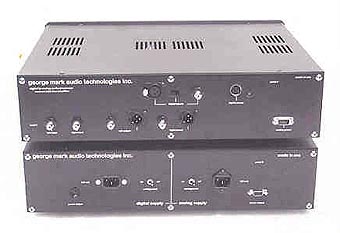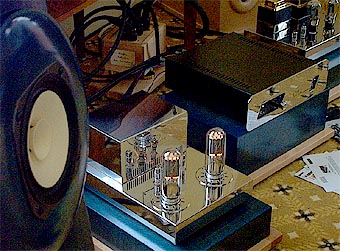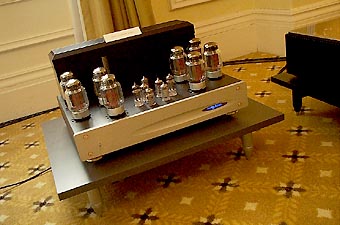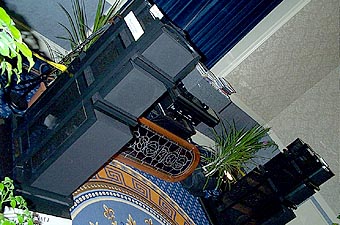 |
||||||||||||||||
| Electrocompaniet showed their new silver Nemesis look, its representative quick to point out that this was a purely cosmetic option, retro-fittable and thus not to alarm existing owners into fretting whether time had marched on and passed them by in the performance sweepstakes. Used in the Talon Audio and -- digital only --Gershman Acoustics displays, the EMC1UP (one up?) fully balanced, 24/192 top loader in particular looked like a miniature fortress ready to battle parasitic resonance pollution with the resolve of the confederacy. >> | ||||||||||||||||
 |
||||||||||||||||
| Similarly impervious to bad- vibes aural weather conditions, the Essence Audio Emerald III monos ($19,850/pr), matching Stereo amplifier ($9,850) and Jasper Reference Preamp ($16,850) performed in the Intuitive Design << room. | ||||||||||||||||
 |
||||||||||||||||
Dale Pitcher is the designer for both lines and clearly obsessed with high-mass energy attenuation. All Essence electronics use quartz casting for mechanical and electrical field damping and now make extensive use of StillPoint's ERS fabric and Bybee's quantum filters. There's no website - interested parties should contact Dale or Sharon Lodge Pitcher at 307-532-2616 (Torrington, Wyoming). |
||||||||||||||||
George Mark Audio Technologies was an unfamiliar name so I grabbed the brochure. Based in Westfield, New Jersey, his First Overture line consists of a Digital Processor/Preamp ($5,990), Digital Processor ($4,990), Preamplifier ($3,990), Preamp/Phono ($$4,990) and a forthcoming stand-alone phono stage. Based on Class A differential vacuum tube technology, 24/192 upsampling and outboard power supplies, future upgrades will include wireless remote control of volume, mute and absolute phase. The stand-alone DAC employs a triode output stage like the processor and preamp. |
 |
|||||||||||||||
 |
||||||||||||||||
| Ofra [left] and Eli Gershman of Canadian Gershman Acoustics showed an upgraded version of their GAP 520X now called the GAP 828 ($13,000/pr in piano-gloss black lacquer, $14,000 in burgundy as shown). Changes include a new port incorporated into the subchassis proper to reduce port resonances and extend low-frequency reach; and xover refinements for improved integration between mid- and bass drivers. As in any Gershman demo I've ever heard, there were no room treatments or fancy decorations, just ballsy wall-to-wall sound. Fellow Canadian Robert Deutsch who probably has far more varied opportunities to hear them than my limited tradeshow exposure enables, commented how he'd never heard 'em better before. Blame for that is likely due to Eli's upgrades but must be shared with the PS Audio PCA-2/HCA-2 pre/power combo, the above-mentioned Electrocompaniet CDP and NordOst cabling. This system only lacked the last word in bass heft/definition that I know the GAPs to be capable of. Here's the kicker. I've heard Gershmans with tube, Class A/B silicon and now switchmode amplifiers ever since I first joined the annual CES parade 10 years ago. They always sounded so musically satisfying that I'd quickly relinquish critical faculties to instead play request after request. That's what happened to me again, accommodating hostess not innocent. It's the best compliment I can make. | ||||||||||||||||
 |
||||||||||||||||
 |
||||||||||||||||
Gill Audio Design is Art Audio's subsidiary. David Gill first joined the crew by submitting the Gill Signature paralleled EL34 triode SET to the firm's line-up. He's since added the Gill Elise Signature 24/96 tube DAC that retains its separate identity yet is marketed by Art Audio. When Kevin Carter, formerly of VAC and now operating K & K Audio joined the design team, the Swedish Lundahl transformers (whose US distributor is Kevin) became available and have since been incorporated into the DAC's Signature version [upper left]. As part of the Art Audio/Cain & Cain exhibit already covered, this all-tube converter driven from the Orpheus Labs Zero and outfitted with its own attenuator for amplifier-direct operation shared responsibility for said room's memorable stand-out performance. |
||||||||||||||||
Inner Sound of electrostatic speaker fame launched its iTube CCDA amplifier ($8,000) which, naturally, is fully endowed to deal with dastardly low-impedance, reactive loads such as presented by electrostatic loudspeakers. Duh. At 150 watts into 8/4 ohms, this amplifier uses massive, custom-designed output transformers, fully differential circuitry and an active servo-bias that avoids the negative feedback effect of cathode-resistor auto bias (often reducing transformer capacity by up to 1/3). Active servo is said to eliminates DC offset on the primary altogether. It also constantly monitors and compensates for bias drift to 1/10th of a millivolt, making the need for matched pairs a thing of the past. A three-stage soft-start circuit and quads of KT88 or 6550 per channel complete the basic specs. |
||||||||||||||||
 |
||||||||||||||||
| The sonic clarity in this exhibit epitomized pellucidness and speed to the ultimate degree. Only my very limited time spent prevented a listing under "Show's Favorites" as sole occupant in the Transparency Class. Yet even the few minutes with one single unfamiliar cut were enough to suspect that Roger Sanders' setup had pushed the boundaries for ultra-resolved, see-thru transparent sound to a new plateau. Having never yet seen the new UltraStat incarnation of the Eros -- now in Mk III iteration -- I was shocked by their super-attractive, nearly ephemeral aesthetics. The pictures on their website don't do them justice. Mine weren't any better. Hence I deleted them and decided to let the amp speak for itself. Drat. Rushing to cover everything shortchanges certain encounters. I missed the MartinLogan exhibit altogether. I had a choice. Spend quality time with Todd Garfinkle of m.a recordings before he closed - or scoot past the software exhibit into Gayle Sanders' suite instead. Sorry, the acquisition of some choice CDs took precedent. Guilty as charged! |
||||||||||||||||
 |
||||||||||||||||
| The Intuitive Design Denali loudspeakers are the second tributary to spring from the mind of Dale Pitcher. The first? The aforementioned Essence Audio electronics. At 500 lbs each, the Denali ($48,500/pr) requires factory installation and uses a modular triple-enclosure design of machined aluminum and granite, each individual chassis transmission-line rear-terminated with multiple vertically aligned minuscule vents and -- via computer-assisted protractor system -- adjustable along the central axis for time alignment. The filter components to the 1st-order Butterworth networks are manufactured in-house. The driver complement consists of a 1" fabric dome tweeter, 6" midrange and twin 7" carbon fiber bass units. A less expensive Pingora version ($19,800/pr) substitutes the tweeter and eschews the framework suspension system yet can be upgraded to Denali status at a later date. | ||||||||||||||||
 |
||||||||||||||||
I really wanted to like this system, seeing how Dr. Jim had traded his Avantgarde TRIOs for these step pyramids and is unmistakably endowed with fabulous musical taste. Alas, on my own recordings, the tonal balance here proved to be anything but what I'm accustomed to. I noted a peculiar lack of midrange presence that created a spacious while hollow and somewhat thin sound. As with many other systems who improved as the days went by and often settled into full bloom only by Saturday, I might have caught this rig in still-unfurling mode. |
||||||||||||||||
| Another assignment from the Congressional Oversight Committee? Like my overlooked MartinLogan exhibit, I can't, as already confessed, report much on the sound of the Grande Utopia Beryllium by JMlab, leashed to multiple Bel Canto Design eVo2s. I was committed to a specific meeting and then vacated the 12th to work my way downhill to the lower floors and avoid the elevator bottleneck. Still, this SOTA effort clearly deserves publicity. In lieu, I present you with a skyscraper image and the following musings on the three largest French speaker manufacturers. Like Cabasse and Triangle, JMlab manufactures all its drivers in-house. Like Cabasse and Triangle, JMlab doesn't seem as concerned with ultimate bass extension and sock as it is with speed and clarity in the midbass. While wholesale categorization invariably invites opportunity to be proven wrong in a hurry, there does seem to be such an animal as a French - well, perhaps not sound per se but still a distinct Sonic Aesthetic. It fancies refinement over grunt, esprit over power. And while I wouldn't call their respective house sounds similar at all, JMlab, Cabasse and Triangle (listed in this sequence to connote their size) do share common ground in this gestalt. Which begs the question. Do certain European audiophiles view us Americans as border-line brutes, happy-go-lucky while unsophisticated adolescents forever enamored with muscle cars and collagen lips? Are some now voicing their US exports in accord with our delight in subterranean pressure wave assaults conditioned by prolonged exposure to Hollywood blockbusters? After all, Wilson Audio is said to subtly adjust their speakers for specific markets, to accommodate national preferences while also accounting for regional building codes that have a huge effect on the relative lossiness of a space. Naturally, these questions shall remain unanswered. |
 |
|||||||||||||||
 |
||||||||||||||||
 |
||||||||||||||||
 |
||||||||||||||||